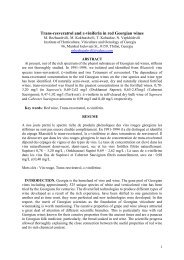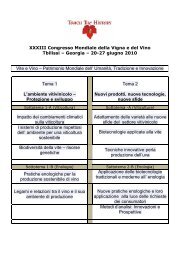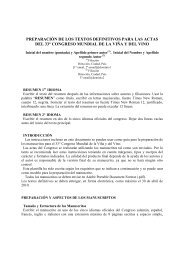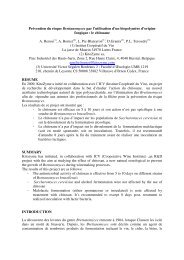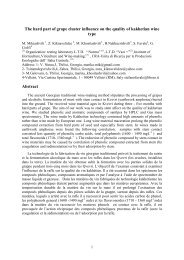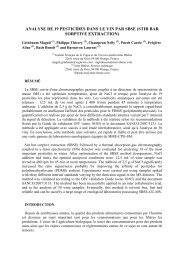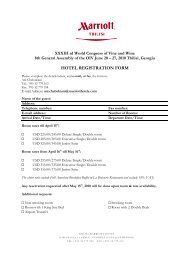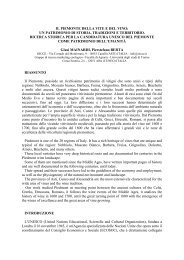exact management of dissolved gases of wines by ... - Oiv2010.ge
exact management of dissolved gases of wines by ... - Oiv2010.ge
exact management of dissolved gases of wines by ... - Oiv2010.ge
Create successful ePaper yourself
Turn your PDF publications into a flip-book with our unique Google optimized e-Paper software.
showed also that 2 mg/L <strong>of</strong> oxygen moreover on white <strong>wines</strong> involved significant sensory<br />
modifications after a few months (Berta et etc., 2000; Boulet, Vidal, 1999). Therefore, various<br />
studies undertaken to characterize the appearance <strong>of</strong> <strong>dissolved</strong> oxygen during operations<br />
performed on <strong>wines</strong> show that bottling is one <strong>of</strong> the most critical phases (Vidal et etc., 2004;<br />
Castellari et etc., 2004), especially as once the bottles have been sealed, the only remaining<br />
means for mastering the evolution <strong>of</strong> <strong>wines</strong> are the storage parameters (closure permeability,<br />
temperature, relative humidity, light, etc.).<br />
On one side, the presence <strong>of</strong> O 2 in the <strong>wines</strong>, following its dissolution, is not a stable state in<br />
time. Dissolved oxygen is gradually consumed <strong>by</strong> various substrates, mainly polyphenols<br />
(Singleton et etc., 1979). The disappearance <strong>of</strong> floral flavours is faster under the effect <strong>of</strong><br />
oxygen additions even at 15°C and at the organoleptic level, aromatic deteriorations arrive<br />
before chromatic deteriorations (Escudero et etc., 2002).<br />
On the other side, CO 2 is produced in a large quantity <strong>by</strong> yeasts (81 g/L for wine <strong>of</strong> 10%<br />
vol.) and lactic acid bacteria (1.6 g/L for 5 g/L <strong>of</strong> malic acid) during alcoholic and malolactic<br />
fermentations. During storage and various treatments <strong>of</strong> the wine, the carbon dioxide content<br />
tends to decrease because <strong>of</strong> the tendency to equilibrate the CO 2 partial pressure <strong>of</strong> the wine<br />
with the atmospheric partial pressure. Finally variable quantities remain at the time <strong>of</strong> the<br />
bottling. However the carbonic gas plays a key role in the organoleptic characters <strong>of</strong> the<br />
<strong>wines</strong>, even if its content is lower than its perception threshold (500 mg/L). Thus adjusting the<br />
carbon dioxide content <strong>of</strong> <strong>wines</strong> has a great importance from the sensorial point <strong>of</strong> view. The<br />
CO 2 content in bottled <strong>wines</strong> will have to be adjusted approximately to 300 mg/L for the red<br />
<strong>wines</strong> for ageing and up to 800-1800 mg/L for the white and rosé <strong>wines</strong>.<br />
Already used in waters, beverages and effluents treatments, membrane contactors present a<br />
great interest in oenology because this new technology enables implementing liquid-liquid,<br />
liquid-gas or liquid-gas-liquid separations. The main component <strong>of</strong> the system is a<br />
hydrophobic porous membrane system. Only <strong>gases</strong> with low molecular weight like O 2 and<br />
CO 2 can pass through this barrier. It is possible to reduce <strong>dissolved</strong> <strong>gases</strong> (eg CO 2 , O 2 ) or to<br />
add for example CO 2 in <strong>wines</strong> before conditioning in bottles or in bag-in box.<br />
After a presentation <strong>of</strong> this new technology and <strong>of</strong> the manual membrane contactor used,<br />
this study describes the first results obtained <strong>by</strong> INRA experimental unit <strong>of</strong> Pech-Rouge<br />
(France) for the <strong>management</strong> <strong>of</strong> <strong>dissolved</strong> <strong>gases</strong> <strong>of</strong> still <strong>wines</strong>. The main aim <strong>of</strong> these trials<br />
was to reduce the <strong>dissolved</strong> oxygen content to a level lower than 0.5 mg/L in order to increase<br />
the shelf life <strong>of</strong> the <strong>wines</strong>. At the same time, the <strong>dissolved</strong> carbon dioxide content is adjusted<br />
to a level between 300 and 1800 mg/L according to the type and the style <strong>of</strong> the wine for<br />
sensorial reasons.<br />
MATERIALS AND METHODS<br />
WineBrane ® membrane contactor:<br />
The WineBrane ® skit (INOXPA patent pending) consists <strong>of</strong> one or several membrane<br />
contactors in the way, that when connected with the operation and secondary medium,<br />
multiple treating processes are possible. The power spectrum <strong>of</strong> the plant covers flow rates<br />
between 1000 and 20000 litres <strong>of</strong> wine per hour for the gas <strong>management</strong> (Schmidt et etc.,<br />
2010).<br />
The design and construction <strong>of</strong> the units is performed in compliance with the requirements<br />
<strong>of</strong> the food-processing industry. The membrane material is polypropylene and it has FDA<br />
approval.<br />
The design is CIP cleanable (alkaline solution and disinfectants), units can also be sanitised<br />
with hot water.



